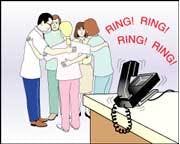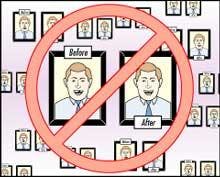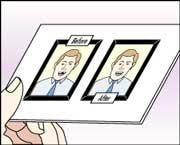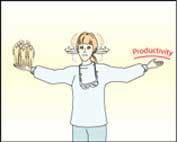by Carol D. Tekavec, CDA, RDH
Theories abound about how dental practices can eliminate problems with patients, payments, insurance, clerical and clinical issues, scheduling, overhead costs, and others. Many of the theories sound practical, and most have been well publicized. While almost any method of practicing might prove to be successful for an individual office in a unique situation, some of the current practice management theories may not hold up under rigid testing. By that, I mean actual implementation in your dental practice.
Change is inevitable in any profession. Most offices who refuse to accept any degree of change or attempt to adapt to new ways of thinking may find themselves in bad circumstances. More progressive dentists and staff will pass the "old fogies" by. Patients enjoy going to an office that is "up-to-date," modern and cutting edge. They want to know that they are receiving the best treatment possible in today's world.
However, making changes without carefully considering who will be responsible for accomplishing the changes, how changes will be implemented and on what timetable, when the changes will be made, and how the changes will be evaluated can cause office chaos. Patients can sense when a practice is on rocky ground. They pick up on staff moods and can tell when changes are not being accepted. In addition, many changes directly affect how patients are cared for. If patients are not carefully prepared, they too may reject the "new ways" and even leave the practice!
Let's look at some of the new practice management concepts and ideas that we hear about. Can these ideas really work in your practice? Here are some "pros" and "cons."
Myth #1
AM and PM "huddles" can streamline the day.
AM and PM huddles have been a popular practice management recommendation for several years. There is little doubt that staff preparation is important. There are several problems, though, that can be associated with "huddles."
• Staff members resent the time spent away from regular duties, or the fact that they have to come in even earlier in the day. Busy staff members may not feel that talking about what is going to happen during the day at the morning meeting and/or going over what did happen at the evening meeting is productive. They may worry that while the meeting is going on, other duties are being left undone. Insurance claims are not being filed, instruments are not being sterilized, and operatories are not being prepared.
The meeting time is also a frequent issue. Since staff must typically arrive well ahead of patients under any circumstance, a required morning meeting can mandate a very early office arrival.
• Unfocused discussion about issues not directly related to patient care. If staff members are already worried about neglected duties, discussion of items not pertinent to the care of patients scheduled for that day can increase irritation and frustration. Talking about a problem concerning a patient who came in last week, or attempting to address a concern better left for a regular staff meeting can make staff members question the value of the huddle. If unfocused discussions are allowed to continue, many staff members will come to look upon the huddles as unnecessary and time-wasting.
• AM huddles may be OK for some offices; PM huddles can delay staff from going home on time. Many practice consultants advocate that all staff members stay until every record is completed, every insurance claim form is documented and/or sent, all cash drawers are balanced, and every operatory is ready for the next day. Resentment can result if everyone is required to wait until every person in the office is ready to go. Most staff members have family responsibilities that cannot be delayed. Consistently going home late can cause a staff uprising.
• No facilitator manages the huddles. If an office is committed to the concept of a staff huddle, it is important for someone to be appointed the facilitator. If the dentist does not want to assume this responsibility, then it should be delegated to a staff person. The facilitator's job is to orchestrate the meeting and prevent some of the aforementioned problems (unfocused discussion, wasted time) from occurring. Without someone "in charge," huddles may disrupt rather than streamline the day.
Myth #2
Transferring clerical duties to the clinical area via computer terminals in the operatories makes an office more efficient.
One management concept that is gaining in popularity is the idea of setting up a dental office as a complete "seamless workstation" environment. This concept eliminates the front desk, the receptionist, a separate area for billing, insurance processing, scheduling, and so on. In other words, all clinical and most clerical activities are handled in the operatory by clinical staff via computer terminals. A few of the advantages cited are fewer staff members needed, greater patient acceptance (since one staff person essentially handles all aspects of treatment), and better control over finances.
What could be wrong with this concept?
Several problems can arise with the "seamless workstation" management plan:
• Differing strengths of clinical and clerical staff make sharing or completely taking over the tasks of the other inherently complex. It is a well-known fact among working dental staff that the temperament of clerical assistants and clinical assistants is usually very different. Clinical staffs prefer and excel with hands-on, patient care duties, while clerical staff prefer and excel at dealing with the "paperwork."
• The arrangement can cause resentment among clinical staff members. Today's dental office is a complicated operation. Busy clinical assistants and hygienists are responsible for more detailed treatment and follow-up work than ever before. In addition, patients must be cared for in a personal and professional manner. If patients do not feel that the staff and doctor have their best interests at heart, trust and confidence suffer. Patients must understand the treatment they are receiving and believe that the procedures are necessary. They must not feel rushed or passed over. They must feel that they are the "center of the universe" during their treatment visit, or they may be tempted to transfer to that less expensive managed care office they have been hearing about. After all, if this office does not "treat me in a special way, how bad can the managed care office be?"
The clinical area must also comply with time-consuming disinfection and sterilization procedures. Trays of instruments and necessary materials must be located and set up prior to each appointment. Radiographs must be exposed, processed and mounted. The dentist must be assisted during patient treatment. Expanded function assistants must perform their segments of the procedures. All instruments must be removed, cleaned, repackaged and made ready to autoclave. Progress notes must be documented. Finally, patient instructions must be delivered and the patient released. All of this must be accomplished during the allotted appointment time or the next patient — and all subsequent patients — will have to wait. If written treatment estimates and conference presentations, appointment scheduling, the posting of charges and payments, insurance claim generation, and money collection are added to the mix, the clinical staff can become overwhelmed and resentful. Portions of the necessary tasks may be reduced, eliminated or simply ignored by a clinical staff too busy to do a good job.
• The arrangement can cause clerical staff resentment. Clerical staff members may have a variety of emotions concerning the idea of the "seamless workstation". Initially they may feel displaced and under-appreciated and may resent having to help clinical staff learn their new duties. Later they begin to grow weary of correcting the mistakes that are bound to crop up. When too many staff members are performing too many shared duties, mistakes are common. Clerical staff often find themselves responsible for putting out constant fires.
When many persons are responsible for many of the same duties, it is also difficult to pinpoint who is causing the "fires." When no one person is responsible for one task, for example, generating insurance claims or filing e-claims, who is responsible when the claim is not processed correctly and payment is delayed or information is lost? Whose job is it to correct the problem and find out what happened to the money?
If collections are down, who makes the collection calls? If an appointment is scheduled incorrectly, who explains this fact to the patient who has driven across town for her appointment that is really scheduled for next week? Who handles the irate mom who thought all of her children had their check-ups this afternoon? Even if it is known which clinical person made the mistake, when will clinical staff find time to correct the issues? Will the clinical assistant who set up an incorrect appointment be required to leave the patient she is working on now (and leave the dentist without an assistant) to take care of the problem?
Will the hygienist who did not process a claim correctly be forced to leave her current root planing patient to talk with the insurance carrier who just called? Will the clinical assistant who presented an incorrect written treatment estimate be required to stop disinfecting her operatory and sterilizing instruments for the next patient (who is already in the reception room) to talk to the disgruntled person on the phone?
If clerical staff (whose numbers will have dwindled since clinical staff is performing clerical duties) have to continually correct mistakes of clinical staff, serious "front office-back office" issues can develop. If no one, clinical or clerical staff, really has the time or the ability to solve problems, the office can be in serious trouble.
• Patients are uncomfortable with the situation. A hygienist recently told me that her office was generating insurance claims and collecting money in the operatory. She said that many of her patients were very uncomfortable with her taking their money at the chair. They often ask her if she and the doctor are afraid that patients are going to try to "get away" without paying. Some of her long-standing patients have told her that it doesn't seem right for her to take care of all of their clinical treatment and then handle all of the paperwork and collect money too. "What happened to the front desk?" they ask.
• Clinical staff experience burnout. Because of increased duties and responsibilities, clinical staff can "burn out." Too little training, too little time, and too much pressure can take their toll. Clinical staff who were drawn to dentistry because they enjoyed working directly with patients, mastering clinical skills, and dealing with the clinical aspect of dental treatment may become discouraged and depressed when faced with so many clerical duties. Just as many dentists find it difficult to deal with the "business" of dentistry, so do many clinical staff.
One practice management assumption said to prevent clinical staff burnout in these situations is the use of a bonus provision. The theory goes that since the practice will be functioning more efficiently and there will be better production and collections with the clinical staff performing clerical duties, a bonus system will be possible to ease the pain of the transition. Unfortunately, this is seldom the case. Even under the best of circumstances with everything working well, the learning curve for change can cause increased profits to be delayed if, in fact, they ever materialize. Bonuses that are promised, but not delivered, only increase feelings of burnout.
Myth #3
Computerized recordkeeping saves time and simplifies paperwork.
While it is true that the entire world is moving toward increased computerization, computerization does not necessarily save time and simplify paperwork. Most offices can testify to the fact that they seem to generate more paper than ever while striving to simplify and/or eliminate paper documentation. The wide variety of computer dental applications further increases uncertainty.
Dentists who want to use digital intraoral cameras, digital radiographs, computerized probes and voice activated charting may find many different applications for each of these services — none of which may work with existing office computer formats. New adaptable computer programs can be purchased. But the financial commitment — when coupled with more time needed for training, and more hardware and cable "pulling" necessary for use — can be daunting.
Recordkeeping and/or scheduling can easily be accomplished in a computerized format, but the office must be aware that "down" times may occur when access to records is impossible. Back-up programs must always be followed without fail to prevent loss of vital information.
Progress notes and other recordkeeping and documentation must be done, regardless of format. Whether notes are handwritten with a crayon on a piece of notebook paper or entered into the most sophisticated computerized format available, the process of documentation requires that someone takes the time to do it.
Myth #4
Insurance e-claims generated in the operatory save time and simplify the claims process.
As previously mentioned, there are problems inherent to clinical staff generating insurance claims in the operatory, but few would argue against the fact that claims can be processed and paid more quickly using e-filing.
Future applications where patient information is sent via e-claims with attachment capabilities (FastAttach, Envoy) can eliminate the need for "physical" attachments. The "attachments" exist in the Internet with access available to those entities with the proper "access numbers," such as the dentist, the patient, and the insurance carrier.
While few carriers have these capabilities now, their numbers are increasing. Problems with operatory claim generation have already been described under Myth #2. The issue is not so much with software capabilities, but with staff predilections.
Myth #5
"Before and after" photographs in the reception room, hallways, operatories, and restrooms generate a patient desire for cosmetic treatment.
While the use of "before and after" photos can be an excellent way of opening up discussion about what types of cosmetic treatments are available, overuse of photos can cause problems.
• Too many photos can lose their impact. While a few pictures can generate interest, too many photos can have the opposite effect. When too much wall space is devoted to cosmetic pictures, patients can tend to "glaze" over. The photos become like wallpaper; there is a pattern but the subject doesn't register.
• Some patients may react unfavorably to the photos. A clinical assistant mentioned to me that many of her patients dislike the photos. She said that they frequently say, "Is Dr. X trying to drum up business?"
Myth #6
"Before and after" recall cards generate patient interest in cosmetic treatment.
As in the case of the "before and after" photos, recall cards with these pictures can be effective if used in moderation and with close attention as to who is receiving the card and what pictures are shown. Without this attention, patient perceptions can be negative.
• Patients may wonder why they are receiving the cards. Staff people have told me that their patients are often uncomfortable with "before and after" recall cards. Reasons given for not liking the cards include:
1. Patients wondering if the staff thinks their teeth look like the ones in the "before" photos.
2. Patients receiving cards depicting a mature man or woman when they are young adults or teens or vice versa. Patients think that the staff and dentist aren't paying attention to them as individuals.
3. Patients thinking that the office is trying to "drum up business."
Myth #7
"Cute" recall cards demean the importance of dentistry.
Many practice management experts warn against the use of silly, funny, or cute recall cards. The thinking is that if a funny recall card is used, the patient will not be inclined to make a recall appointment. A funny card is thought not to depict an office serious about caring for the dental needs of patients. So why should the patient take the need for a recall appointment seriously?
In reality, many patients enjoy funny cards. It turns out that serious cards do not necessarily make patients more serious about dentistry. Funny or cute cards enable an office to show its lighter side and can sometimes even result in better responses than more somber cards.
• Recall cards that reflect the dentist and staff are usually well received. If a funny or cute recall card reflects the general demeanor of the office, that card is right for patients. Being humorous often can make patients feel more at ease and more inclined to receive dental treatment, and therefore more inclined to make recall appointments too. While false attempts at humor can fall flat, genuine wit is usually appreciated.
Myth #8
For maximum productivity, hygienists should be able to see at least 10 patients per day.
While every office wants the hygiene department to be highly productive, there can be problems with the idea of "per day" quotas of appointments. Seeing scores of patients is not necessarily synonymous with high productivity.
• Productive appointments are typically longer appointments. Just as in the restorative area of dentistry, labor intensive hygiene procedures that take longer than standard prophies are typically more productive for the office. In addition, patients may prefer longer appointments, where more is accomplished at each visit.
For example, most patients would prefer having two quadrants of root planing and scaling performed on one side of the mouth at one visit rather than four separate visits for each quad. It is also known that periodontal maintenance procedures require specified data collection and treatment not typically possible during a standard prophy time allotment. Both root planing and perio maintenance are higher dollar procedures than prophies, requiring more of the hygienist's time.
• Short appointments generate more "back-up" work such as sterilization, recordkeeping, insurance forms, scheduling, and payment collection. Will these back-up processes be the hygienist's responsibility? A hygiene assistant's responsibility? Other clinical or clerical staff responsibility? Who will be responsible for these procedures when reducing hygiene appointment time and/or establishing daily quotas? If these issues are not addressed in advance, hygienist burnout, patient dissatisfaction, and staff unrest is likely.
• The entire office team influences the hygiene schedule and therefore influences any quota. The hygiene schedule needs someone to confirm patients either two days or one day before treatment, utilize a call file to fill in cancellations, use a written treatment conference form to underscore the importance of hygiene visits, and prepare written "scripts" for front desk staff answering the phone. The hygienist might be physically able to see a certain number of patients each day, but other considerations might prevent it.
Myth #9
A hygiene assistant can effectively solve the problem of seeing more hygiene patients per day.
Many offices are reportedly using a hygiene assistant to perform those duties that do not require a hygiene license. This assistant typically seats patients; updates medical histories; performs and records blood pressures; exposes, processes and mounts radiographs; assists the hygienist by using the suction during the procedure; records periodontal probing depths; makes all record notations; (in some states) performs coronal polishing (in Kansas, also performs coronal scaling); goes over home care procedures; performs office fluoride treatments; sets up the next patient appointment; dismisses the patient; cleans and disinfects the operatory; and cleans and sterilizes instruments.
Optimum use of a hygiene assistant requires access to two designated hygiene operatories. While the hygienist is scaling and performing licensed duties in one operatory on one patient, the assistant is in the other operatory performing the other duties on another patient.
Hygiene/hygiene assistant scheduling may work to increase the number of patients seen during a typical day, particularly for days scheduled for standard prophys only. However, several problems are associated with the use of a hygiene assistant:
• Having only one operatory available for scheduling. Either the hygienist or the assistant will encounter down time, which eats away at production increases, if there is not access to two operatories.
• Hygienist experiences burnout. When only scaling procedures are performed, physical and psychological complications can arise. Neck, back, arm, and especially hand and wrist fatigue can take their toll, as well as a mental "treadmill" feeling. Without breaks from the intense physical labor of scaling and/or root planing, exhaustion is common.
• Patients may miss the personal interaction with the hygienist. The office hygienist has traditionally been the one person who patients could count on seeing at least twice a year, if not more often. Most hygienists become very familiar with their patients and are instrumental in providing a sense of continuity for patients. When patients are seen for scaling only, the personal touch of the hygienist may be lost.
• Missed opportunities occur for patient diagnosis and treatment. The hygienist often is the one who "discovers" (later diagnosed by the dentist) problems or conditions which fuel continued office production. If the hygienist is concentrating only on scaling, chances for identifying possible treatment can be diminished.
Myth #10
In a successful practice, all members of the dental team are aware of the need for selling office dentistry.
There is a large difference in perception and execution between "selling" and "educating" patients about dental procedures. It is the accepted duty of dental personnel to provide patients with all the information available concerning possible dental treatments and corrections for their problems. However, "selling" dentistry is usually perceived negatively by both patients and staff.
• Patients are sophisticated and react unfavorably to "selling" techniques. If patients do not believe that the dentist and staff have their best interests at heart, they will not accept treatment suggestions.
• Pointing out possible treatment needs requires tact and diplomacy on the part of staff members.
If staff do not feel qualified to discuss issues or are uncomfortable with the process, patients will be uncomfortable too. Simply pointing out problems and making suggestions is not necessarily conducive to treatment acceptance. Patients may feel embarrassed, may have money worries, or any of a dozen other issues.
• Patients need to be able to trust the dentist and staff. If they feel that "selling" is occurring, trust suffers.
• Education about conditions and treatment procedures is much preferred to selling.
Using educational videos, brochures, photos, and charts is important in letting patients know about their options. When patients are educated about their options, they have the chance to choose the quality dentistry we want them to have. When they feel that we are selling a particular procedure, they may choose not to have a procedure that they really need.
Myth #11
Dental products provide an important profit center for most successful practices.
More and more practices are providing and selling dental products directly from the office. While making products available as a convenience for patients might be advisable, and obtaining a profit for these products would be expected, setting up a "dental store" has certain pitfalls.
• If not handled dexterously, patients may perceive product sales as unprofessional. A plan for handling the sales must be carefully thought out and adhered to by all staff.
• Patients may feel pressured to buy products. Patients may feel pressure to buy, particularly in offices that have adopted the practice of requiring payment for today's treatment while the patient is still in the operatory. When product sales and operatory collections are combined, patients may feel overwhelmed by money-generating efforts and unappreciated as patients. Rather than complain, these patients often simply leave the practice.
• Staff members may resent time taken from regular duties to sell products. Again, if product sales are combined with an office philosophy that requires clinical staff to perform most clerical duties, the time required for product sales will not be perceived positively. Product sales require ordering and inventory maintenance, product stocking, money collections and money balancing for the day, maintenance of the product sales area, and other related activities.
Myth #12
Dental offices should strive to eliminate insurance "dependency."
It is currently popular to disavow working with patients' dental insurance. A few dentists have been able to successfully eliminate filing claims for patients with a good result. These dentists have been able to show that their office income has actually increased, that patients are perceiving the care they receive in a more positive light, that patients receive better benefits when they file claims themselves, and that staff has been freed from dealing with insurance problems.
All of these possible positive results make most dentists long for the chance to eliminate dental insurance from their practices.
While eliminating dental insurance is possible for a dental practice, dentists should take note of the following before "taking the plunge."
• An ADA poll taken during 2000 demonstrated that a lack of insurance was the top reason most respondents listed for not visiting the dentist. While dental personnel put dental care at the top of the list of "needs" for a healthy life, the general public does not yet perceive it that way. Money continues to be a major obstacle to care.
• Patients who have insurance generally receive more treatment than patients without. Also according to the ADA, when a patient has help in paying the bills, he or she is more likely to go ahead with both necessary and elective treatment.
• Dentists who refuse insurance must be prepared to lose a certain number of patients. Many patients are unable to navigate their insurance plan "maze." While it is true that the employee benefits coordinator where they work is the proper person to assist with claims, most patients rely on the expertise of their dental office. The employee benefits coordinator usually has little dental knowledge; the dental office staff understands what treatment is needed and why it should be performed.
The ability to pay is not the only reason that patients want the dental office to work with insurance. Even patients with more than enough income want their insurance to pay the maximum allowed. Patients who are not inclined, or who feel that they are not able to do their own paperwork, may leave the office. Each dentist must realistically decide how many patients he/she is willing to lose, particularly in communities with a high percentage of a certain type of insurance or a certain employer.
(It is important to remember that insurance plans should not dictate treatment. Insurance benefits can be viewed as simply another mechanism to help patients pay — just like credit cards, health cards, or finance plans.)
Dentists and staff are bombarded with new practice management ideas and concepts every day. Each office should carefully analyze how the new ideas might work in their own practice before beginning to use the new processes. People who do not actually use the concepts in real clinical practice promote some of these ideas.
When a new concept is embraced, a definite plan for implementing the concept including who will handle the details, what exactly will be done, where activities will be performed, and when the concept will be carried out, needs to be in place.
Carol Tekavec, CDA, RDH, is the author of the Dental Insurance Coding Handbook and the patient brochure, My Insurance Covers This ... Right? She is also the designer of a dental chart, an informed consent booklet, and a scheduling system, as well as a national lecturer. Still practicing as a clinical hygienist in a general practice office, she can be contacted at (800) 548-2164 or visit her Web site at www.steppingstonestosuccess.com.












